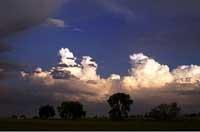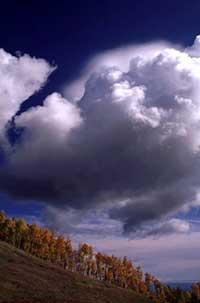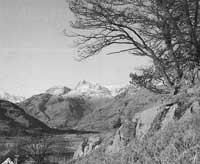Ozone layer, climate thermometer of the planet
2000/07/23 Kortabarria Olabarria, Beñardo - Elhuyar Zientzia

Ozone is the molecule formed by the three atoms of oxygen. It is an invaluable gas, without color and with a pleasant smell. The molecule is oxidizing and corrosive. It may appear in the stratosphere or troposphere of the Earth's atmosphere and depending on it may affect the environment in some way. The ozone that appears in the stratosphere is beneficial because it does not let filter the ultraviolet rays sent by the Sun, so it gives protection. For its part, tropospheric ozone is harmful to the environment, since at that height it becomes pollutant.
Ozone does not come from direct sources of contamination, so it is considered a secondary pollutant. It appears when mixed with solar radiation from other pollutants, nitrogen oxides and organic compounds. Nature itself can also form tropospheric ozone by binding natural nitrogen oxides, solar radiation, some organic compounds and stratospheric ozone. Therefore, the only option to avoid or reduce ozone formation in the troposphere is to reduce emissions of nitrogen oxides and organic compounds of industrial and transport origin.
The troposphere is one of the lowest layers of the atmosphere and 5-10 kilometers thick. In this climatic layer of the planet it is determined, among other things because the clouds form there. Tropospheric ozone is mainly due to secondary reactions in heavily contaminated areas.
Ozone beneficial?

In addition to the benefits of stratospheric ozone, some experts consider the advantages of another type remarkable. For example, a group of researchers working on water treatment ensures that in addition to disinfecting ozone, it kills bacteria and stops viruses. Not only that, according to some scientists working in the field of medicine, penetration into the blood increases the ability of cells to carry oxygen, while killing viruses or bacteria that may exist in cells. Ozone is used in circulatory blood problems, in cases of colitis, in some types of cancer, fistulas, skin infections, burns, increased cerebral blood circulation.
In spite of their high price than chlorine, they use ozone to make water drinkable. However, being a powerful oxidizer, if not used carefully can be dangerous. However, excessive ozone emission to water can cause problems, mainly respiratory and lung irritations.
In addition to water purification, it is used to purify the air and clean the gases that generate dirty water. Being oxidizer has been used to whiten waxes, oils, flours and tissues.
Chopped layer?
Despite its growing use on Earth, the real role of ozone is in the sky, in the stratosphere. Ozone collection takes place at a height between 20 and 40 kilometers, so this part of the atmosphere is called the ozone layer. In fact, the stratospheric ozone layer protects the Earth from the ultraviolet rays emitted by the Sun and therefore from all beings here. The Sun sends, among others, ultraviolet rays -UV- and this type of radiation can be harmful to beings depending on their intensity and their exposure time.
In the case of humans, from the health point of view, ultraviolet radiation can produce skin erythema and eye diseases, in addition to causing a deterioration of the immune system. Nature can slow plant growth, including phytoplankton (microscopic plants suspended in water), so life on Earth and at sea would be in danger.
Therefore, it is evident that the stratospheric ozone layer is in good condition. A question that can have a certain solution is, moreover, that society can assume if the necessary measures are taken. When the ozone layer problem began to emerge, however, human activity was not thought to have so much influence.

In 1974 two American scientists discovered that some chemical compounds composed of chlorine, fluorine and carbon, called CFCs, are capable of destroying ozone. These compounds are of frequent industrial use. Freon refrigerators and air conditioning facilities is CFC and is also used in some sprays and paints. The discoverers had to be subjected at first to criticism from the companies that manufacture these products, but years later society had to recognize that the ozone layer on Antarctica was getting smaller and that the use of CFCs had a great influence. In addition to CFCs, there are other compounds that damage the ozone layer: halons used in extinguishers, HCFCs, bromine, etc. All these substances are very stable and can have an average life of more than 100 years, so they can reach the stratosphere when emitted into the atmosphere. Radiation from solar ultraviolet rays in the stratosphere causes the release of chlorine atoms from chlorofluorocarbons. These atoms break the ozone molecule by releasing an oxygen molecule and a chlorine monoxide molecule. Oxygen molecules break the chlorine monoxide molecule and the chlorine atom is released again, so the process restarts. The process is very harmful, as a single chlorine atom can destroy 100,000 ozone molecules. The chlorine atom repeats the process until it meets a chemical compound that can slow down.
Due to the growing ozone hole, international agreements have been adopted in Vienna in 1985 and Montreal in 1987. At this last meeting, about 90 countries joined in half in two years of production of ozone perforating products. More measures have been taken, but the fact that the Antarctic ozone layer is getting thinner is not a good sign.
Published in 7

Gai honi buruzko eduki gehiago
Elhuyarrek garatutako teknologia





